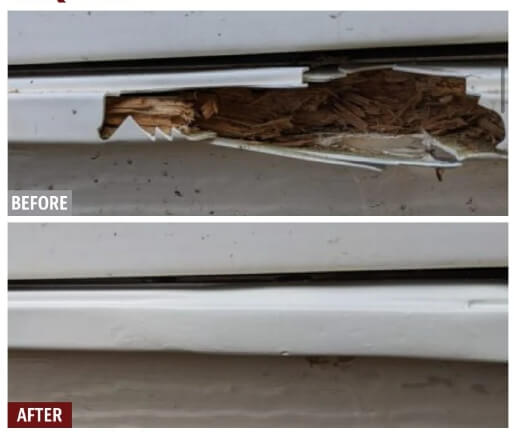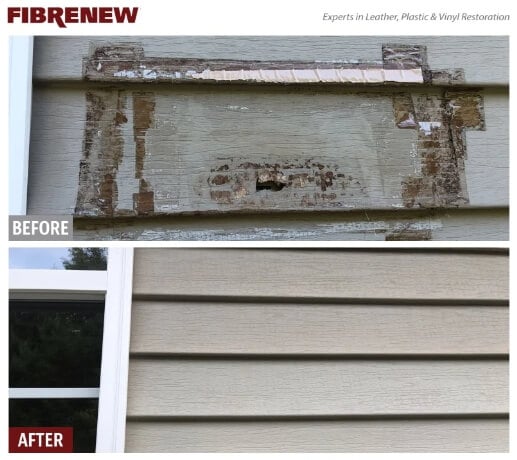The Miracle that is Vinyl Siding Repair
Vinyl siding has long been a popular choice for homeowners due to its durability, low maintenance, and aesthetic appeal.
Yet, even the most resilient materials can face wear and tear over time. Imagine waking up one morning, stepping outside with your coffee, and noticing a crack or a small hole in your otherwise pristine home siding. It’s easy to feel a pang of worry about the potential costs and hassle of fixing it.
But here’s the good news: vinyl siding repair is not only doable but often a surprisingly simple and cost-effective solution for home improvement.

Understanding vinyl siding
First, let’s dig a little into what vinyl siding is.
History and Popularity
Vinyl siding first appeared on the market in the late 1950s as an alternative to aluminum siding. It quickly gained popularity due to its affordability and ease of installation.
Over the decades, advances in siding installation have significantly improved its durability and aesthetic options, making vinyl siding a go-to choice for modern homes. Home siding adorns millions of houses nationwide today, providing a practical and attractive exterior finish.
Benefits of Vinyl Siding
Durability: Vinyl siding is known for its resilience. It can withstand harsh weather conditions, from torrential rains to strong winds, without deteriorating quickly, making it an excellent choice for homeowners looking for a long-lasting exterior material.
Low Maintenance: Unlike wood, which requires regular painting and sealing, vinyl siding needs minimal upkeep. A simple wash with a garden hose and mild detergent can keep it looking fresh and new.
Cost-Effectiveness: Vinyl siding is relatively inexpensive compared to other siding materials like wood or fiber cement. Additionally, its low maintenance requirements translate into long-term savings, as homeowners spend less on upkeep and repairs.
Aesthetic Appeal: Available in various colors and styles, vinyl siding can mimic the look of more expensive materials like wood or stone. This versatility allows homeowners to achieve their desired look without breaking the bank.
Understanding these key benefits makes it clear why vinyl siding remains a popular choice among homeowners. Its blend of durability, low maintenance, cost-effectiveness, and aesthetic appeal makes it an attractive option for anyone looking to enhance their home’s exterior.
Common issues with vinyl siding
Some run-of-the-mill hazards to watch out for.
Types of Damage
Home siding can encounter a few common issues over time despite its durability. Understanding these problems can help you address them more effectively and maintain the pristine look of your house siding.
Cracks and Holes: Small cracks and holes can appear for various reasons, including physical impacts from hail, falling branches, or even errant baseballs. These minor damages can compromise the integrity of the siding if not addressed promptly.
Warping and Buckling: Vinyl siding can warp or buckle due to excessive heat or improper siding installation. This usually occurs when the siding panel is nailed too tightly, preventing it from expanding and contracting with temperature changes.
Fading and Discoloration: Prolonged exposure to sunlight can cause house siding to fade or discolor over time. While modern siding is more resistant to UV damage, older installations might show signs of fading, affecting the overall appearance of your home.
Causes of Damage
Weather Conditions: Extreme weather conditions are a significant cause of damaged siding. Hail can cause dents and cracks, while strong winds can dislodge panels. In areas prone to severe weather, inspecting your siding regularly is crucial.
Physical Impact: Accidental impacts, such as sports activities or lawn maintenance equipment, can cause visible damage to your siding. These incidents are often unavoidable but can be quickly fixed with the right repair techniques.
UV Exposure and Aging: Over time, UV rays from the sun can degrade the material, leading to brittleness and fading. While modern vinyl siding is treated to resist UV damage, older installations might still be vulnerable, requiring occasional repairs or replacement siding of affected sections.
Understanding these common issues and their causes helps homeowners proactively maintain their home siding. Regular inspections and prompt repairs can significantly extend the lifespan of your siding, keeping your home looking its best year-round.
The miracle of vinyl siding repair
It truly is miraculous how we can transform damaged siding into something that looks brand new again. Here are some other benefits and examples.
Cost-Effectiveness
One of the most appealing aspects of vinyl siding repair is its cost-effectiveness. Compared to full replacement, repairing specific sections of your siding can save you significant money. When you fix only the damaged pieces, you avoid the expense of purchasing new siding for the entire house and the labor costs associated with a full installation. This targeted approach allows homeowners to maintain their budget while still addressing necessary repairs.

Simplicity and Convenience
Vinyl siding repair is surprisingly straightforward, making it an ideal DIY project for those who enjoy tackling home improvement tasks. Basic repairs often require just a few tools and materials, which are readily available at most hardware stores. For instance, small cracks can be fixed with vinyl patch kits and caulk, while larger holes might need a new piece and basic carpentry skills. The modular nature of vinyl siding allows individual panels to be removed and replaced without disturbing the surrounding sections, adding to the convenience of repairs.

Environmental Benefits
Repairing vinyl siding instead of replacing it contributes to environmental sustainability. By fixing damaged sections, you reduce the amount of waste that ends up in landfills. This eco-friendly approach conserves resources and minimizes the environmental impact associated with manufacturing new siding. Furthermore, maintaining your existing siding can extend its life, reducing the need for frequent replacements and promoting a more sustainable lifestyle.

Vinyl siding repair is a practical and efficient solution that offers numerous benefits. Its cost-effectiveness, simplicity, and environmental advantages make it an attractive option for homeowners looking to maintain their home’s exterior without incurring excessive expenses. Whether you’re dealing with minor cracks or more significant damage, understanding the miracle of vinyl siding repair can help you keep your home looking its best while preserving your budget and the environment.
Step-by-step guide to vinyl siding repair
Assessment and Preparation
Inspecting the Damage: Inspect your home siding to identify all damaged areas. Look for cracks, large holes, warping, and discoloration. It’s important to assess the extent of the damage to determine the appropriate repair method.
Gathering Necessary Tools and Materials: Once you’ve identified the damaged pieces, gather the necessary tools and materials. Common tools include a utility knife, zip tool, pry bar, hammer, nails, and measuring tape. Materials might include vinyl patch kits, replacement siding panels, caulk, and color-matching exterior paint.
Basic Repair Techniques
Fixing Small Cracks and Holes: Use a vinyl patch kit and caulk for minor cracks and holes. Clean the damaged area thoroughly, apply the adhesive, and press the patch into place. Ensure it’s smooth and level with the surrounding siding.
Replacing Damaged Panels: If a siding panel is beyond repair, it must be replaced. Start by using a zip tool to unlock and remove the damaged panel. Measure the new piece to fit the space, cut it to size, and snap it into place, securing it with nails. Make sure the new piece aligns perfectly with the existing siding.
Matching Colors and Textures: Vinyl siding comes in various colors and textures, so matching the replacement siding material with your existing siding is crucial. Most hardware stores can help you find a close match, or you can order samples from the original manufacturer.
Advanced Repair Techniques
Addressing Warping and Buckling: Warped or buckled panels need careful attention. Remove the affected panels, check the underlying structure for damage, and ensure its level. Install new panels, leaving enough room for expansion and contraction to prevent future warping.
Handling Complex Repairs: Areas around windows, doors, and corners may require more intricate repairs. Use corner posts and trim pieces to ensure a seamless look. Precision is key in these areas to maintain the integrity and appearance of your siding.
Professional vs. DIY Repairs
When to Call a Professional: While many vinyl siding repairs can be handled by DIY enthusiasts, some situations warrant professional help. Extensive damage, structural issues, or lack of confidence in your repair skills are good reasons to call in a professional. They can ensure the job is done correctly and safely.
Tips for Finding a Reliable Contractor: If you hire a professional, research to find a reputable contractor. Look for reviews, ask for recommendations, and verify their credentials. Obtain multiple quotes to ensure you get a fair price for the work.
By following these step-by-step guidelines, homeowners can effectively tackle vinyl siding repairs. Whether you’re handling basic fixes or more complex issues, proper assessment, preparation, and technique are crucial to achieving a seamless and durable result.
Maintenance tips to prolong the life of vinyl siding
Here are some basics to keep your vinyl siding lasting as long as possible.
Regular Cleaning
Best Practices for Cleaning Vinyl Siding: Keeping your vinyl siding clean is crucial for maintaining its appearance and longevity. Use a garden hose to rinse off dirt and debris. Mix a solution of mild detergent and water for tougher stains, and use a soft-bristle brush to scrub the siding gently. Avoid using high-pressure washers, as they can damage the material.
Recommended Cleaning Products: When choosing cleaning products, choose those specifically designed for vinyl siding. Avoid harsh chemicals like bleach or abrasive cleaners, which can cause discoloration or damage the siding’s surface.
Preventive Measures
Protecting Siding from Physical Damage: Take steps to minimize the risk of physical damage to your siding. Trim back any overhanging tree branches that could fall and cause impact damage. Be mindful when using lawn equipment near the siding, and avoid leaning heavy objects against the house.
Strategies to Minimize UV Damage: While modern vinyl siding is more resistant to UV damage, providing some protection is still beneficial. Planting trees or installing awnings can provide shade and reduce direct sunlight exposure, helping to maintain the color and integrity of your siding over time.
Routine Inspections
Importance of Regular Inspections: Regular inspections are key to catching early signs of damage before they become major issues. Inspect your siding at least twice yearly, ideally in the spring and fall. Look for signs of cracking, warping, or loose panels.
Identifying Early Signs of Damage: During your inspections, pay close attention to any changes in the appearance of your siding. Early signs of damage might include slight discoloration, small cracks, or areas where the siding is pulling away from the house. Address these issues promptly to prevent further deterioration.
By incorporating these maintenance tips into your routine, you can significantly extend the lifespan of your vinyl siding. Regular cleaning, preventive measures, and routine inspections help keep your siding in top condition, ensuring your home remains attractive and well-protected for years to come.
Fibrenew: Your vinyl siding repair gurus
Vinyl siding repair truly is a miracle solution for homeowners looking to maintain the beauty and integrity of their homes without incurring significant costs. With its numerous benefits, including durability, low maintenance, cost-effectiveness, and aesthetic appeal, vinyl siding has become a favored choice among homeowners.
Get in touch with your local Fibrenew professional for all your leather, plastic, and vinyl repair needs.
Want to run a business that gives you incredible earning potential and the flexibility to take control of your time and life? Join the Fibrenew Family!
Check out our free Franchise Information Report for everything you need to know.
Also, enjoy these valuable resources on all things leather, plastic, and vinyl repair, franchising, sustainability, and more:
What are the common causes of vinyl siding damage? Vinyl siding can be damaged by various factors, including extreme weather conditions, physical impacts, and aging. Hail, strong winds, and falling branches are common culprits, while everyday activities like sports or yard work can also cause damage. In older houses, prolonged exposure to UV rays can lead to fading and brittleness. How do I replace a damaged piece of vinyl siding? To replace a damaged piece of vinyl siding, you will need a zip tool, utility knife, and nails. First, use the zip tool to unlock and remove the damaged panel. Measure and cut the new piece to fit, then snap it into place and secure it with nails. Make sure the new piece aligns perfectly with the surrounding siding. Can I use caulk to repair small cracks in vinyl siding? Yes, caulk can be used to repair small cracks in vinyl siding. Use a high-quality, paintable exterior caulk to fill in the cracks. After applying the caulk with a caulk gun, smooth it out with a putty knife or your finger and allow it to dry completely. This helps to seal the crack and prevent water from penetrating the siding. Is vinyl siding repair different for an old house than a new one? Repairing vinyl siding on an old house might present additional challenges due to the siding’s age and possible underlying issues like degraded sheathing or framing. Inspecting the underlying structure carefully and ensuring it is in good condition before replacing or repairing the siding is essential. Older houses may also have discontinued siding styles, so finding matching replacement pieces can be more challenging. How can I prevent mildew from forming on my vinyl siding? To prevent mildew from forming on your vinyl siding, ensure proper ventilation around your home and regularly clean it. Use a mixture of water and mild detergent and scrub with a soft-bristle brush. For stubborn mildew, a solution of vinegar and water can be effective. Keeping your siding clean and dry will reduce the chances of mildew growth. Can I paint over the vinyl siding repairs? Yes, you can paint over vinyl siding repairs. Use a high-quality, paintable sealant for any cracks or gaps, and choose an exterior paint designed for use on vinyl. Make sure the repaired area is clean and dry before applying the paint. Painting can help blend the repaired section with the rest of the siding and enhance your home’s overall appearance. What should I do if I find water damage behind my vinyl siding? If you find water damage behind your vinyl siding, it’s crucial to address it promptly. Remove the affected siding panels and inspect the sheathing and framing for any signs of damage or rot. Replace any damaged sheathing or framing materials, and use a waterproof sealant to protect the repaired areas. Ensure proper flashing and water barriers are in place before reinstalling the siding panels. How often should I inspect my vinyl siding for damage? It’s a good practice to inspect your vinyl siding at least twice a year, ideally in the spring and fall. Regular inspections can help you identify and address minor issues before they become major problems. Look for signs of cracking, warping, loose panels, and gaps that might allow water to penetrate the siding. Can I repair vinyl siding myself, or should I hire a professional? DIY enthusiasts can handle many vinyl siding repairs, especially if the damage is minor. However, it’s wise to hire a professional for extensive damage or if you’re unsure about your repair skills. Professionals can ensure the job is done correctly and safely, particularly for complicated issues involving underlying structures or large sections of damaged siding. How do I choose the right sealant for vinyl siding repairs? When choosing a sealant for vinyl siding repairs, look for a high-quality, paintable, and waterproof sealant designed for exterior use. Ensure it is compatible with vinyl and flexible enough to accommodate the siding’s expansion and contraction. A good sealant will help protect your siding from water infiltration and improve the longevity of your repairs. Can damaged vinyl siding affect my roofing or drywall? Yes, damaged vinyl siding can potentially affect other parts of your home, including roofing and drywall. Water infiltration through damaged siding can lead to moisture buildup in the sheathing and framing, eventually causing issues like mold, mildew, and rot. This can spread to the drywall inside your home and even compromise the integrity of your roofing if not addressed promptly. Regular maintenance and timely repairs are essential to prevent such problems. By addressing these common questions, homeowners can better understand the nuances of vinyl siding repair and efficiently maintain their home’s exterior. Proper care and timely repairs can ensure the longevity and aesthetic appeal of your vinyl siding, protecting your investment for years to come.Vinyl siding repair FAQ
